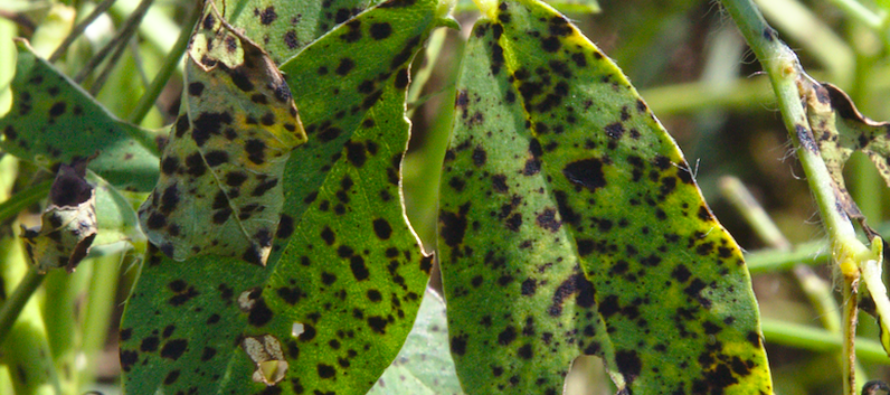Late Season, Early Leaf Spot Movement

Related Articles
- Evaluation of Peanut Varieties in Mississippi, 2010 0
- Evaluation of Peanut Prescription Rx Program in Mississippi 0
- Evaluation of Tillage Systems as Related to Peanut Yield 0
Latest Tweets

Figure 1. Peanut leaf with “freckle”-like lesions on the leaflets. The freckle-like lesions on this petiole were caused by Late leaf spot. Note the petiole lesion between the first and second groups of petioles. This almost guarantees that either early or late leaf spots are causing these symptoms.

Figure 2. Peanut leaf with “freckle”-like lesions on the leaflets. The freckle-like lesions on this petiole were caused by Early leaf spot. Note the petiole lesion between the first and second groups of petioles. This almost guarantees that either early or late leaf spots are causing these symptoms.
Early leaf spot (https://www.mississippi-crops.com/2013/08/12/early-leaf-spot-of-peanut/) can seriously defoliate peanuts, leading to yield losses and perhaps inversion problems that inhibit pod drying.
Leaf spots generally require some hours of free water (dew, guttation, irrigation) on the leaf for the fungal spores to germinate and infect. Thus leaf spots are generally more aggressive in rainy times or during extended dew periods.
If fungal infection occurs, but conditions are not ideal for further development, infection can present as a black “freckle”-like lesion (see the two images above, Figure 1 and 2). Other fungal leaf spots can cause similar symptoms. However, if the field has early or late leaf spot, then the “freckle”-like lesions probably belong to them. The petiole lesions between the first and second leaflets in the images pretty much clenches it.
Despite the very dry weather in northeast Mississippi, early leaf spot has continued to slowly move in fields until many of them contain an entire areas of the canopy full of the freckle-like lesions along with a few typical lesions such as those shown in the two images above (Figure 1 and 2). Between the dry weather and the leaf spot, defoliation is slowly occurring, with some field areas are as much as 30% defoliated.
I have watched this type of advance before, especially in our former Disease Nursery in Lackey where we had been breeding for earlier peanut varieties. However, I have not seen it be as aggressive as it is this year.
The weather forecast is predicting that the ridge over northeast Mississippi may have chances breaking and yielding scattered showers and thunderstorms this weekend.
If your fields have the “freckle” problem and you are waiting for rain to dig, and they get rain, then I suggest that you dig as promptly as you can.
If, like many, you still need more time for pod maturation, consider applying a good, curative fungicide prior to the potential showers. Leaf spot defoliation can occur rapidly when water reappears. Chlorothalonil (most commonly used as Bravo or Echo) is a topical fungicide and works to prevent infection. The presence of the “freckles” mean that infection has already occurred. Since, for the most part, full lesion development and spore production has not occurred, a curative should be helpful.




Let me tell You a sad story ! There are no comments yet, but You can be first one to comment this article.
Write a comment